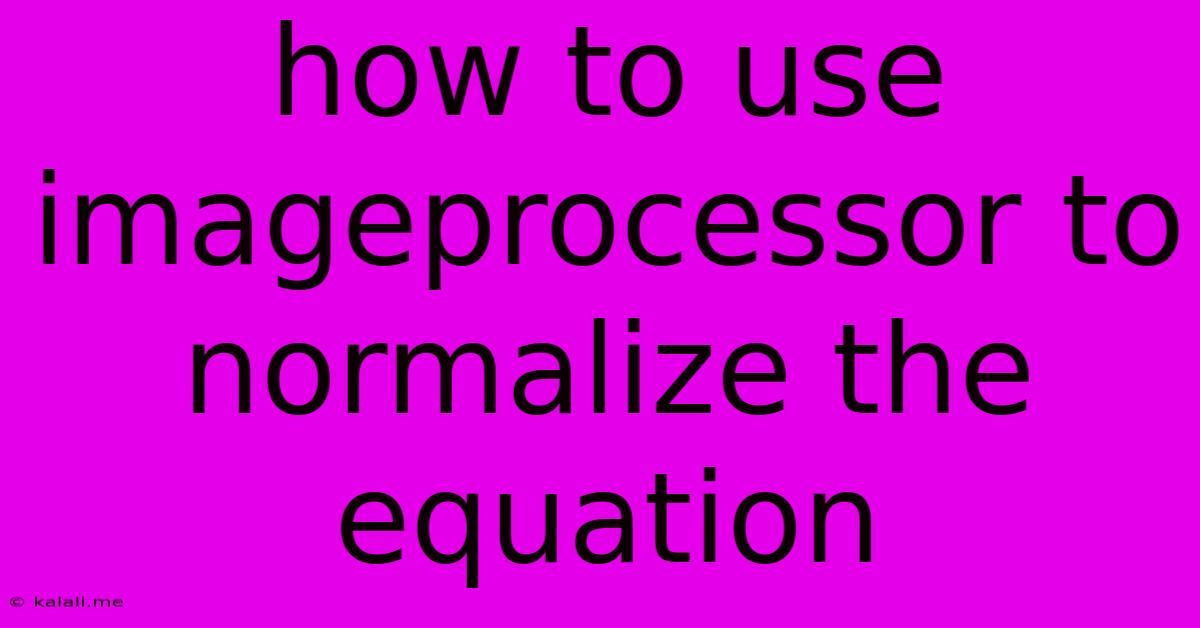How To Use Imageprocessor To Normalize The Equation
Kalali
Jun 03, 2025 · 3 min read

Table of Contents
How to Use ImageProcessor to Normalize Equations in Images
This article explores how to leverage the ImageProcessor library (or similar image processing libraries) to normalize mathematical equations found within images. This process, crucial for tasks like Optical Character Recognition (OCR) and automated equation solving, involves cleaning up and standardizing the image of the equation to improve the accuracy of subsequent processing steps. While ImageProcessor itself doesn't directly "solve" equations, it's a powerful tool for pre-processing images containing them, making them more suitable for OCR and further analysis. This guide focuses on the pre-processing steps using techniques readily available in image processing libraries. Think of it as preparing the equation image for a "recipe" that would then use OCR and equation solvers.
What is Equation Normalization?
Equation normalization in image processing aims to improve the quality of the equation image, making it easier for OCR engines to accurately extract the mathematical symbols and structure. This involves several steps, such as:
- Noise Reduction: Removing irrelevant background noise or artifacts.
- Binarization: Converting the image to black and white to simplify the equation's representation.
- Skew Correction: Straightening any tilted equations.
- Cropping: Removing unnecessary whitespace around the equation.
- Contrast Enhancement: Adjusting brightness and contrast for better readability.
Steps using ImageProcessor (or equivalent library):
While ImageProcessor doesn't have dedicated "equation normalization" functions, we can chain together several operations to achieve this. Remember to install the necessary library: pip install ImageProcessor. The following steps outline the process, adaptable to other libraries like OpenCV or scikit-image.
1. Load the Image:
First, load the image of the equation using ImageProcessor. Assume you have an image file named equation.png.
using ImageProcessor;
using ImageProcessor.Imaging;
using System.Drawing;
// ... other using statements ...
using (var imageFactory = new ImageFactory())
{
imageFactory.Load("equation.png");
// ... further processing ...
}
2. Noise Reduction:
Apply a suitable noise reduction filter. ImageProcessor offers several filtering options depending on the type of noise. Experiment to find the best filter for your specific image. A median filter is often a good starting point.
imageFactory.MedianFilter(3); // Adjust kernel size as needed
3. Binarization:
Convert the image to a binary (black and white) image using thresholding. This simplifies the image and makes it easier to process.
imageFactory.Threshold(128); // Adjust threshold as needed. This is a simple threshold; consider adaptive thresholding for better results.
4. Skew Correction:
Skew correction requires more advanced techniques usually found in dedicated OCR libraries or using external image processing tools. ImageProcessor might not directly support this, but you might be able to use a Hough Transform technique which involves detecting lines in the image and then using that information to correct the skew. This step often requires external libraries.
5. Cropping:
Crop the image to remove any unnecessary whitespace. You'll need to determine the bounding box of the equation manually or using contour detection (again, may require external libraries).
// This requires prior bounding box determination (x,y, width,height)
// Assuming you have these values in 'x', 'y', 'width', and 'height'
Rectangle cropArea = new Rectangle(x, y, width, height);
imageFactory.Crop(cropArea);
6. Contrast Enhancement:
Enhance contrast to improve readability. ImageProcessor provides options for brightness and contrast adjustments.
imageFactory.Brightness(10); // Adjust value as needed
imageFactory.Contrast(10); // Adjust value as needed
7. Save the Normalized Image:
Finally, save the processed image.
imageFactory.Save("normalized_equation.png");
Conclusion:
This guide demonstrates how to utilize ImageProcessor (or comparable libraries) for essential preprocessing steps in equation normalization. While ImageProcessor may not handle every aspect perfectly, it provides a solid foundation for image cleaning and improvement. The combination of ImageProcessor with other specialized OCR and image processing libraries or algorithms will yield the best results for complex equation normalization tasks. Remember that optimal parameters for each step are image-dependent and may require experimentation.
Latest Posts
Latest Posts
-
Wiring A Switch For A Garbage Disposal
Jun 05, 2025
-
Finding The Natural Response Of A Ivp
Jun 05, 2025
-
What Dice To Roll For Sleight Of Hand 5e
Jun 05, 2025
-
How To Feed Young Month Old Pigeons Food
Jun 05, 2025
-
What Is Standard Water Pipe Size In Residential
Jun 05, 2025
Related Post
Thank you for visiting our website which covers about How To Use Imageprocessor To Normalize The Equation . We hope the information provided has been useful to you. Feel free to contact us if you have any questions or need further assistance. See you next time and don't miss to bookmark.